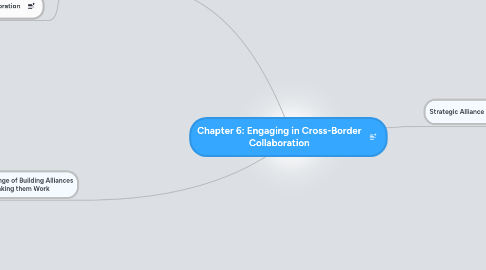
1. Risks and Costs
1.1. Two fashionable management concepts in the 80's
1.1.1. Triad Power
1.1.2. Stick to Your Knitting
1.2. Risk of Competitive Collaboration
1.2.1. Competitive Collaboration
1.2.2. You strengthen your competition
1.2.3. Competition can learn from you
1.2.4. Might be precursor to takeover
2. Challenge of Building Alliances and Making them Work
2.1. Pre-Alliance
2.1.1. Analysis - Partner Selection
2.1.1.1. Need Data on Partner
2.1.1.2. Overcome barriers in physical and cultural distance
2.1.1.3. Impossible to predict how partnership will develop
2.1.2. Negotiation - Escalating Commitment
2.1.3. Decision Making - Alliance Scope
2.1.3.1. Complicated cross-holdings of ownership & equity
2.1.3.2. Need for cross-functional coordination or integration
2.1.3.3. Scope of joint activities
2.2. Post-Alliance
2.2.1. Coordination - Managing the boundaries
2.2.1.1. Choose the right boundaries
2.2.1.1.1. SA can be independent legal organization with complete freedom to manage tasks
2.2.1.1.2. Operations can be managed by both parents
2.2.2. Integration - Managing Knowledge Flows
2.2.2.1. Ensure full exploitation of learning potential
2.2.2.2. Prevent outflow of information/knowledge that you don't want your partner to have
2.2.2.2.1. Gatekeepers: Interface Managers
2.2.3. Adaptation - Providing Strategic Direction
2.2.3.1. Effective Governance Structure
2.2.3.1.1. Integrative Quality
2.2.3.1.2. Companies must agree on SA leaders and try their best to help them
3. Strategic Alliance
3.1. Types
3.1.1. Joint Venure
3.1.2. Patent Licensing
3.1.3. Franchising
3.1.4. Cross-Licensing
3.1.5. R&D Consortia
3.1.6. Co-Production/Buyback
3.1.7. Cooperation Agreement
3.2. Trends
3.2.1. Alliances between companies and industrialized countries
3.2.2. Focus shift from distribution to creation of new products
3.2.3. Strategic Alliances for last a short time
3.3. Motivations
3.3.1. Technology Exchange
3.3.2. Global Competition
3.3.3. Industry Convergence
3.3.4. Economies of Scale
3.3.5. Reduction of Risk
3.3.6. Alternative to Merging

